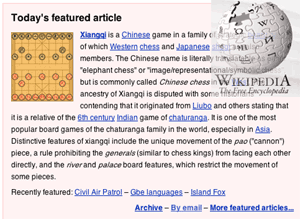Yesterday’s post from Andy Carvin’s weblog, Turning Wikipedia into an Asset for Schools, ignited a lot of discussion on the blogsphere, especially considering that it’s the middle of July, and most educators are catching up on novels, family time, or dealing with vacation. Waking up at my usual, insanely early hour, I had his plan and a podcast I’m working on in my head. As it happens, I have an enormous amount of audio, mostly interviews, saved up on my hard drive, probably enough for two months worth of weekly podcasts. Last night I started editing together  two interviews with NECC attendees, who also happened to be ISTE affiliate officials as well. They both mentioned blogs and podcasting as the technologies the were interested in learning more about, and they talked about these technologies within a context that I want to hone down to a finer point. Actually, it is my nature to hone things down to three points — four if there’s no way around it.
two interviews with NECC attendees, who also happened to be ISTE affiliate officials as well. They both mentioned blogs and podcasting as the technologies the were interested in learning more about, and they talked about these technologies within a context that I want to hone down to a finer point. Actually, it is my nature to hone things down to three points — four if there’s no way around it.
Being the information intensive endeavor that education is, it is important that we apply our curriculum and its technologies to the changing nature of information. This is how you integrate literacy into what and how you teach, by integrating the new information environment. There are essentially three characteristics of information today, that were largely not present in the information environment that I grew up in.
Information is:
- Networked — This is what gives rise to the read/write web, expanding the infospace beyond universal readership to universal authorship. This is why we have to stop teaching students to assume authority of information and, instead, prove authority.
- Digital — All information is expressed as ones and zeros. This renders not only numbers as processable, but also text, images, sound, animation, and video. Many people today make a living by processing information, adding value to it in some way. The current trendy term for it is re-mixing. …and our children are very good at this.
- Overwhelming — When I was growing up, you had to go someplace to find the information, and that information was largely stored in limiting containers (books, bookshelves, libraries). Now we carry access to a global reservoir of information from straps on our shoulders and even in our pockets. How does what we have to say, compete for attention?
I’ll talk more about how this applies to blogging and podcasting in my next podcast program. But Andy’s scenario plugs in brilliantly.
First, students are addressing the fact that the definition in the WikipediA came out of a network that is universally (our goal) readable and writable. They are also going out into that network and skillfully finding information that proves the authority of WikipediA’s content (or disproves) and they are supporting the content with references to sources, making it easier for future readers to prove authority.
Second, students are probably doing a good bit of re-mixing. They are finding content, and folding that content into what is already there, hopefully adding value. They may also be finding other media (images, sound, video) and manipulating that media, so that it more effectively applies to the topic at hand.
Finally, students are reassembling the information in order to have the article most successfully communicate itself, and even draw the reader’s interest in, competing for his or her attention.
When I feel generous, I’ll throw in a forth bullet, and that is that the students are performing all of these tasks with a mind on the ethical use of information, that what they are doing takes no credit or monetary value from legal information owners, does not damage the value and reliability of the information, and in no way causes harm to anyone or group of people.
2¢ Worth.
585

One thought on “What’s the Target (or the Three Bullet Man)”